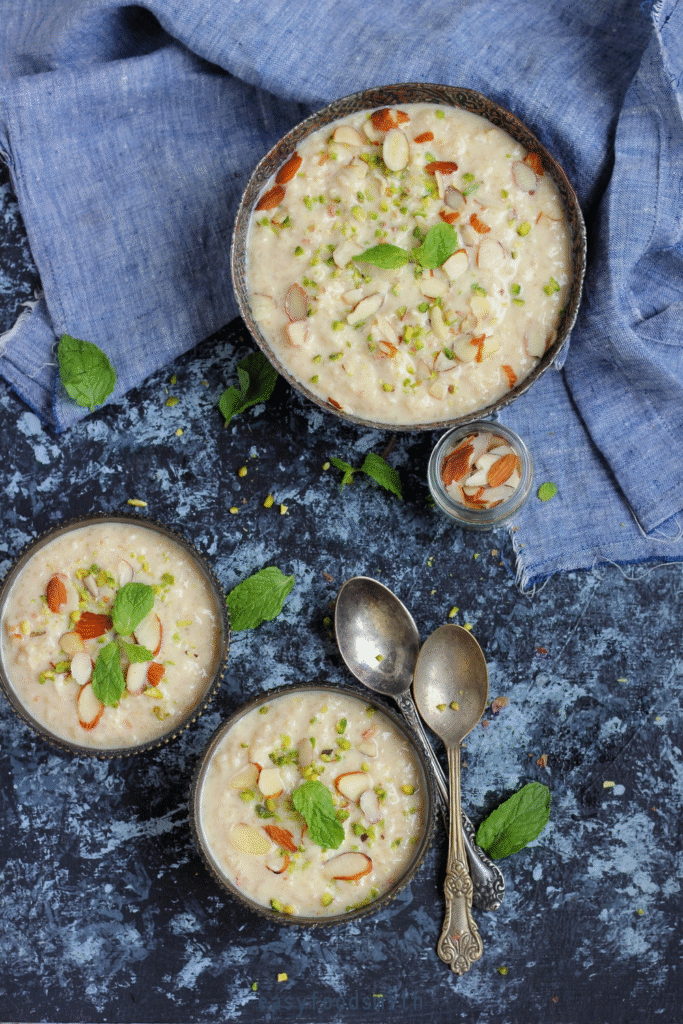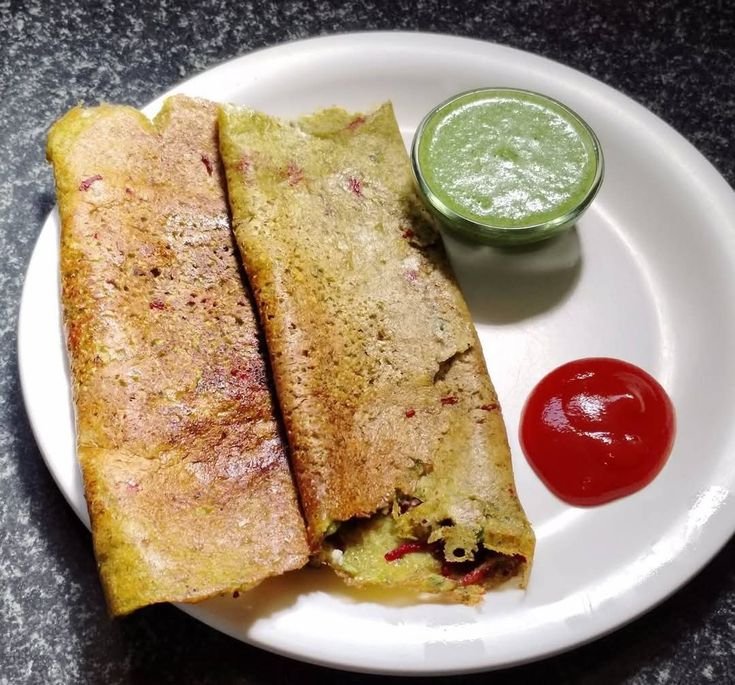
Hare Krishna, devotees. 🌸
Let’s take a deep breath today and slow down for a while. Leave aside the noise, the rush, the chaos of modern life. Come sit beside me — like two old friends, or perhaps like a devotee sitting at the feet of their Thakurji — and let’s talk about kheer.
Not just as a dessert, but as a prayer. A whisper of devotion. A simple, sacred offering that has graced the plates of temples and homes for centuries.
Because kheer is not just a dish. It is a bhog. A memory. A story. A feeling.
And today, I’ll walk with you — step by step, heartbeat by heartbeat — as we prepare this creamy bowl of sacred sweetness for our beloved Lord Krishna.
📿 What is Kheer? Why is it so Divine?
Kheer, in its most basic sense, is just sweetened milk cooked slowly with rice. But in the world of devotion, it’s something else entirely. It is the essence of satvik cooking — simple ingredients, pure intentions, no harsh spices, no fancy twists. Just warmth. Just love. Just simplicity.
Why do devotees offer kheer to Krishna?
Because it’s cooling, comforting, and deeply nourishing. Just like Krishna’s own presence in our lives. Sweet, gentle, calming.
When you make kheer, it’s like telling God: “I don’t have much… but I offer you what I have — milk, rice, sugar, and my love.”
🌾 Ingredients – Not Just Items, But Symbols of Bhakti
Let’s first look at what we’ll need. But more than just listing them, let me share what they mean — spiritually.
- Full cream milk – 1 liter
Milk is sacred. It’s considered the food of purity, of cows, and of Lord Krishna himself. He grew up around cows, drank their milk, and loved everything made from it. - Basmati rice – 3 to 4 tablespoons
Rice symbolizes life, sustenance, and patience. The way it slowly softens into milk — so beautiful. - Sugar – 5 to 6 tablespoons (adjust to taste)
Sweetness is essential in bhakti. Not just on the tongue but in our actions, words, and thoughts. - Cardamom (elaichi) powder – a pinch
A gentle fragrance, just like our silent prayers. - Saffron strands (optional) – 4 to 5 soaked in warm milk
Used in temple preparations, saffron gives color and grace to the dish. - Chopped nuts (cashews, almonds, pistachios) – 1 to 2 tablespoons
Add them if you like, but keep them humble. This is not a hotel dessert. This is Krishna’s bhog. - Tulsi leaves – 1 or 3 for garnishing
Because no bhog is complete without Tulsi Maharani.
🪔 Before You Begin – Prepare Your Mind Like You Prepare Your Kitchen
Bhakti begins not in the pot but in the heart.
Before you enter the kitchen, wash your hands and feet. Tie your hair. Change into clean clothes. Light a diya near your mandir.
Play a soft kirtan if you want. Or just chant quietly — “Hare Krishna, Hare Krishna, Krishna Krishna, Hare Hare ,Hare Ram, Hare Ram, Ram ,Ram, Hare Hare ”
Even while stirring milk, if your lips are softly uttering the name of the Lord, you are no longer cooking — you are doing seva.
🍚 How to Make Kheer – The Heartful, Slow, Satvik Way
Now come, let’s begin. Slowly. With love. No rush.
Step 1: Wash the Rice
Take 3–4 tablespoons of basmati rice in a bowl.
Rinse it gently 2–3 times until the water runs clear.
Then soak it in water for 20–30 minutes. This makes it soft and helps it cook evenly.
While it soaks, take a breath. Maybe sit by your altar, chant a few malas, or just close your eyes and think of Krishna’s playful face.
Step 2: Boil the Milk
Take 1 liter of full cream cow’s milk in a thick-bottomed kadhai (or heavy pot).
Turn the flame on low to medium. Let it come to a gentle boil.
As it heats, keep stirring slowly so it doesn’t stick at the bottom.
There’s something so meditative about watching milk swirl and rise… the smell, the sound of the ladle…
Even the silence in the kitchen becomes sacred.
Let it reduce a little — that’s when it becomes creamy and divine.
Step 3: Add the Rice
Now drain the soaked rice and add it to the boiling milk.
Keep the flame on low.
Stir occasionally, not just to prevent burning, but with love — as if you’re rocking a cradle. Krishna is in every grain.
Let it simmer. Let it be. Let the rice soften slowly, take its time.
Don’t be in a hurry. The more it simmers, the more the milk thickens, the deeper the flavors develop.
Kheer teaches you patience. Humility. Surrender.
Step 4: Add Sweetness
Once the rice is cooked and the kheer has thickened slightly, add 5–6 tablespoons of sugar.
Watch how it melts into the mixture — just like ego dissolving in devotion.
Taste and adjust if needed. But don’t over-sweeten. Let the natural milkiness shine.
Step 5: The Final Fragrance
Add a pinch of cardamom powder.
If you’re using saffron, add it now — with its golden hue spreading like early morning sunlight.
You may also add a few chopped nuts, lightly roasted if you prefer.
But always remember — the heart of the dish is milk and rice. The rest are optional blessings.
🥣 Serve with Devotion
Once the kheer has cooled slightly, pour it into a clean bowl. Silver or earthenware is best, but anything simple and clean is perfect.
Garnish with a Tulsi leaf. Yes, even if you have only one — it is the dearest offering to Krishna.
Place it on a clean thali. Maybe add a flower, a diya, a soft cloth napkin beside it. Offer with love.
Say a small prayer. You don’t need Sanskrit. Even a heartfelt “Krishna, this is for you” is enough.
Then sit quietly. Let Him taste it with His divine glance. And after a few minutes — when your heart feels full — share the prasadam with everyone at home.
🪶 More Than a Dish – It’s a Sadhana
Do you know why elders insist that kheer is auspicious?
Because it combines milk (symbol of compassion), rice (symbol of grain/life), sugar (sweetness), and patience (time). It is not rushed. It is not stirred in irritation. It is prepared when the cook is peaceful, when the home is quiet, when the soul is in offering-mode.
In fact, on festivals like Janmashtami, Sharad Purnima, Kartik Purnima, or on Ekadashi nights (when broken next morning), kheer is often the first thing made for Krishna.
There’s a story in Vrindavan that on Sharad Purnima, the moon drips nectar onto kheer kept under moonlight. That’s how sacred this dish is.
🌸 A Story from a Simple Devotee’s Life
Let me share something personal.
Once, I had only half a liter of milk, a handful of rice, and not much else. But it was Janmashtami. I didn’t want to skip making bhog. So I sat, and with trembling hands, made a tiny pot of kheer. No nuts, no saffron. Just milk, rice, and sugar.
As it cooked, I kept singing “Govinda Jai Jai, Gopala Jai Jai…” softly.
When I offered it, I cried. Because I felt Krishna right there. Not in form, but in presence. In that gentle warmth that filled the room.
Later, when I shared that prasadam with others, it was as if I had shared a miracle.
Never underestimate the power of simple offerings made with pure love.
🌕 Final Thoughts – Let Kheer Be Your Daily Prayer
You don’t need a grand kitchen to cook for Krishna.
You don’t need a hundred ingredients.
You don’t need to be a chef.
You just need a soft heart. A quiet moment. A desire to please Him.
Kheer is like Krishna himself — creamy, comforting, and quietly powerful.
So next time you feel disconnected… don’t scroll. Don’t worry.
Just walk into your kitchen.
Boil some milk. Wash a little rice.
And make a small bowl of kheer.
Offer it to Him. Talk to Him. Tell Him how you’re feeling.
And then taste the prasadam — feel how it heals you, how it hugs your soul from the inside.
Hare Krishna 🙏
May your kheer be creamy.
May your heart be calm.
May your home be filled with the fragrance of bhakti.
And may Krishna always accept every morsel you offer — with His sweet, mischievous smile.
🌼 Jay shree radhe , Hare krishna



